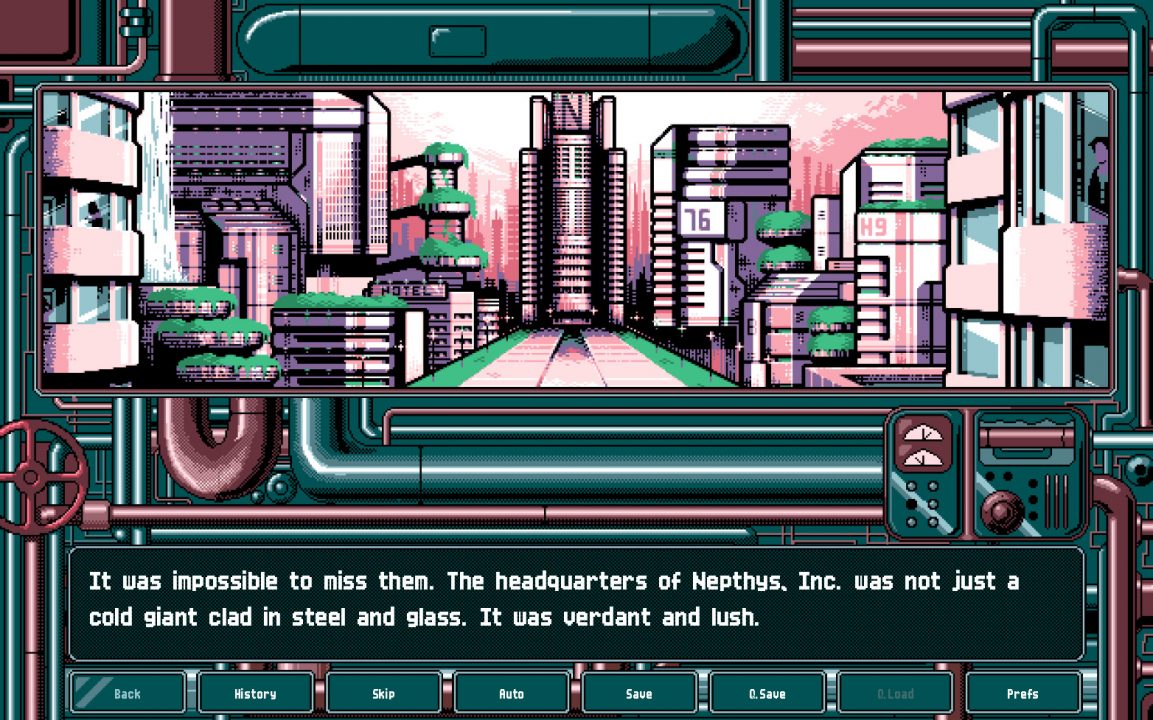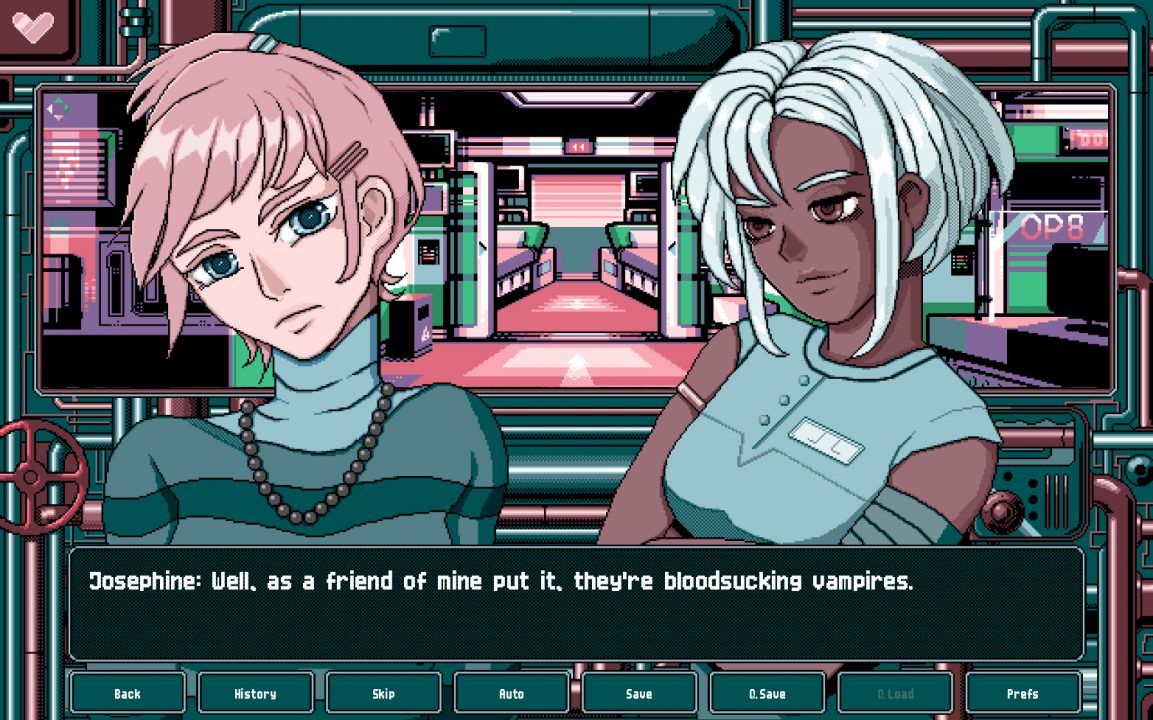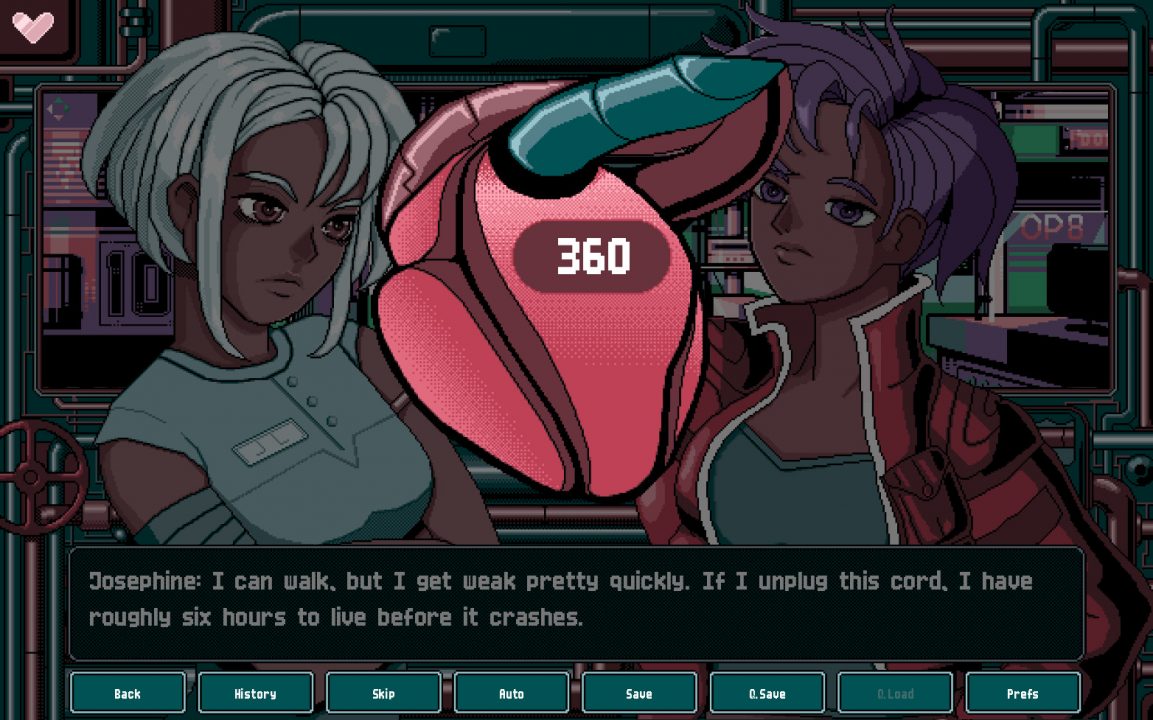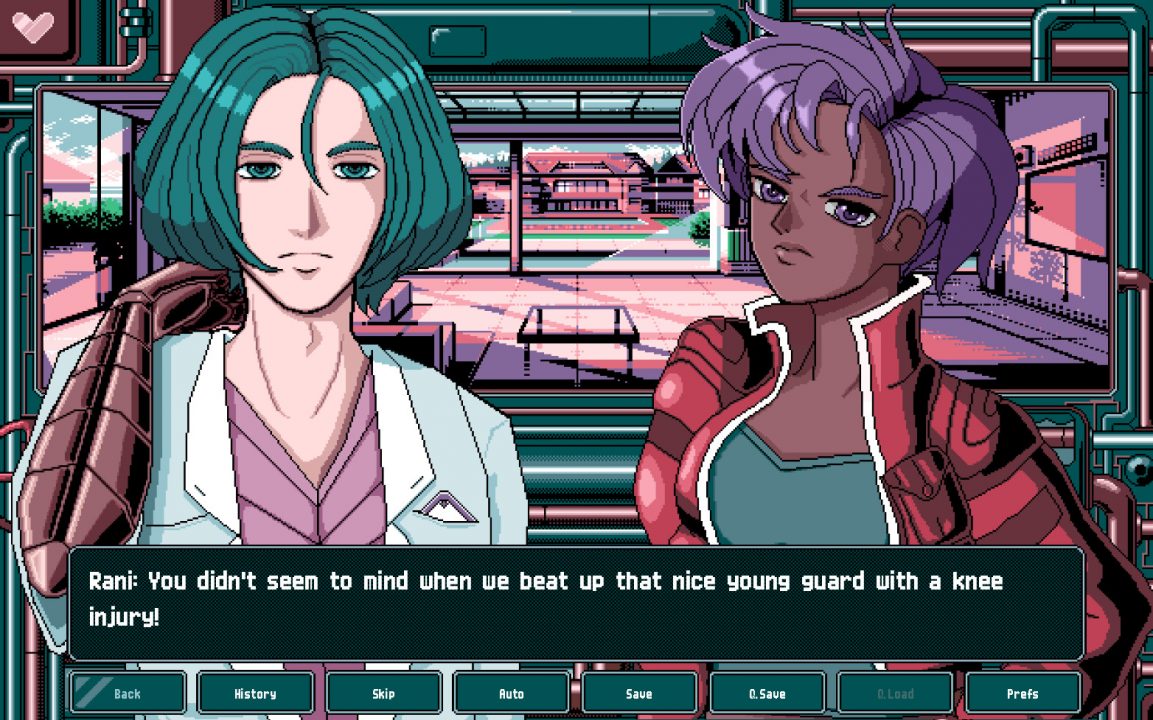Vengeful Heart is essentially a kinetic visual novel, with only one choice altering the outcome of the title’s final chapter. By their very nature, kinetic VNs live or die by the strength of their narrative. Fortunately, the game’s plot is well-written and very compelling. Josephine Lace works as a hydraulic engineer in a futuristic city where water is the most precious and valuable resource. The private sector conglomerate Nepthys, Inc., led by the charismatic young businessman Francis Brabeck, has a growing monopoly on water rights and is poised to climb to even greater heights thanks to Josephine’s own designs to acquire groundwater.
In this city, the upper class live far removed from the concerns of the middle and lower classes who struggle for every drop of water they can get. Josephine hopes to one day count herself among the elite, ignoring how bad things truly are until her own middle class apartment building is targeted for demolition in order to implement her new design. She inspires her neighbors to stand up in protest against Nepthys, but things go horrifically wrong when the company sends in private security forces. Josephine loses a great many people along with her heart, both in a symbolic and quite literal sense, and the now cybernetic Josephine lives for nothing but revenge against her former employers.
Vengeful Heart‘s sociopolitical commentary is thought-provoking. Being wrapped up in an engrossing cyberpunk narrative about revenge with believable characters, many of whom see significant growth and development over the course of the narrative, only further strengthens it. Josephine’s quest for vengeance ultimately brings together four very different people: Rani Janis, a former soldier now moonlighting as private security who used to be one of Josephine’s neighbors; Norbert Maturana, a kindhearted doctor who specializes in cybernetic surgery for a hospital that keeps patients alive solely so they can work off their medical bill debts; Robert “Bob” Larsen, a fifty-something heart attack survivor who has personally experienced just how raw a deal the lower class can get; and Amy Sierra, an idealistic college activist who helps run a feminist student union despite being from an upper class background herself.

Through their interactions with one another and the residents of the city at large, all four characters grow in phenomenal ways to form something akin to a family unit alongside Josephine. I especially loved the development shown by Amy in both story routes, as she went from being a wide-eyed idealist who wasn’t aware of what was actually going on in the world around her to someone who genuinely wants to and actively helps make a positive change for others. Bob’s gruff-but-kind demeanor and how he ultimately warms up to Amy like a little sister is also wonderful to see take shape, and I love how sensitive Norbert and fiery Rani both represent different ideological viewpoints but still learn to respect each other and work together. Everyone’s reactions to what they see and participate in are incredibly real and believably written.
Other characters also shine throughout the narrative: Catrina is a lower class single mother trying to provide water and safety to her three young children, and Catrina’s oldest son ends up finding himself in one of the most harrowing scenes due to that naive innocence only children possess. Mr. Kendrick, the somewhat racist elderly neighbor of both Josephine and Rani, ends up having some very insightful reveals and poignant character moments as the protest in their apartment building early on continues. There’s Jim, a private security guard who isn’t really that bad of a person and wants to support his sister who is transitioning but isn’t exactly sure how to do so; and Tina, a TV news reporter who encounters Josephine incognito and just may want to pursue the truth even more than Nepthys’ sponsorship allows if given the chance and enough evidence. Even Francis Brabeck ends up being a memorable antagonist due to his goals of wanting to entirely privatize water distribution and government to create what he views as an “ideal” society, which is excellent given how the focus of so much of the story is on revenge against him.

The main draw of Vengeful Heart‘s story is ultimately Josephine Lace herself, who starts off as a willfully ignorant individual aiming for the top without ever considering others until she lands in the middle of a conflict she helped in large part to create. Josephine grows and evolves as a character due to the tragic events that play out around her, becoming ashamed of who she was in the past as she strives to get back at Nepthys and help those people she may have previously walked past or even hurt as she tried to advance her career. She is a determined character with many strengths and flaws, and ultimately both story routes you can take her down make so much sense given how the narrative plays out beforehand.
The story is a well-crafted cyberpunk tale, populated by a diverse cast of characters. It can get very dark and intense at times (a particular scene with a small child discovering a bomb will always haunt me), but that makes sense for the serious messages the game is trying to convey. There’s a lot of graphic descriptions of death and violence when things escalate, which can be hard to read at times. The two endings for the game range from realistic to bittersweet and hopeful, which I greatly appreciated. After all, reaching them can be quite harrowing and painful, so a completely “happy” or “good” ending would have felt tonally out of place.
I appreciate that, while the game does offer two romance options, the one narrative choice players have to make ultimately boils down to the positive and negative consequences of different ideological viewpoints, rather than focusing on relationship values. Since there is no story map, I recommend saving when you reach that one choice segment to see how both final chapters play out. You may prefer one ending over the other, but they both make a lot of sense if Josephine’s character growth is looked at from even just slightly different lenses.

The weakest plot point of Vengeful Heart is the romance itself. Josephine has two love interests — Norbert and Rani — and the game believably writes her as being very much in love with both of them and conflicted over it. The two love interests know of this, and it creates some additional tension within the group. I didn’t think the ways her relationship could evolve with either Norbert or Rani were necessarily bad. In fact, I quite liked both characters and their differing dynamics with Josephine. But I’m not sure if the romance was absolutely necessary either, given the game’s general storyline and how Josephine could have easily picked between the two characters based on their differing viewpoints instead. The romance angle seems added on in some respects, which is strange when everything else about the plot feels much more relevant. For romance fans though, I do think that the Norbert and Rani outcomes are both heartfelt in differing ways.
Vengeful Heart is roughly five to six hours, comprising of eight chapters (nine if you consider that the final chapter can go in two different directions). The story is written by Elmo Mustonen, with script work by Hanuli and editing by Jessica M. Chavez. I spotted only one typo while I played, which is impressive given just how much text the game has.
The game’s art and graphics are colorful, comprised of what I can only describe as a “neon pastel” color palette; pinks, greens, blues, and purples are the dominant scheme, making for quite a unique look as far as cyberpunk tales go. Given their typically darker visual undertones, Vengeful Heart stands out in the genre. I love how the detailed sprite art instantly brings to mind anime sci-fi classics like the original Bubblegum Crisis, and the character designs truly pop and stand out. For visual consistency, I do wish certain NPCs such as Mr. Kendrick or Jim had gotten character art too, but they’re described in vivid detail in the narrative itself. The UI is quite uniquely designed as well and fits the sci-fi aesthetic. After beating the game once, you unlock a highly-detailed and intricate gallery that shows you early character sketches and designs along with artist notes. The overall art and design of the game is done by Hanuli, with background art by Dmitry Petyakin.

Music for Vengeful Heart is primarily composed by D. Ray, though other artists also contribute some song pieces to the soundtrack. Such notable tracks include “Cyborg Destiny” by Zodik, “Precious Things” by Electronic Senses, and “Goddess” by Sequel Police. All of the tracks excellently capture the feel of a futuristic setting with their synthetic undertones, and sound effects such as dripping water or the beeping of Josephine’s heart monitor during tense situations are used brilliantly. Similar to the gallery, a jukebox unlocks after finishing the game once that allows you to hear select music tracks.
Since Vengeful Heart is a kinetic visual novel, there isn’t much to do during the course of the game beyond pressing the button to move to the next line of text. There is a heart monitor for Josephine that players can access once she acquires her cybernetic heart, though it’s just used to further gauge how tense a given scene is. You can access a history log at any time when you need a refresher on something said a few lines back, and you can save anywhere, too. The help section of the main menu gives you the controller button layout, and you have skip choices for text as well as the ability to chose text speed and auto-forward time. The volume control or mute for music, blips, and sound effects can also be found in the options section of the main menu.
Vengeful Heart is an all-around solid VN with a powerful story. It was developed using Ren’Py by only a handful of people, and the quality of their work is absolutely incredible to behold! Vengeful Heart made me think and feel so many things as I progressed through it, something I wish more narratives in general could do. If you enjoy well-crafted cyberpunk tales with memorable characters and abundant social commentary, then you’ll definitely want to give this colorful kinetic visual novel a try.


